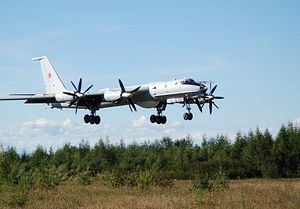Two Russian Tupolev Tu-142MZ maritime reconnaissance and anti-submarine warfare aircraft conducted an aerial patrol off the coast of Alaska and Canada last week, according to North American Aerospace Defense Command (NORAD). The aircraft reportedly entered the Alaskan Air Defense Identification Zone (ADIZ).
The Russian Ministry of Defense (MoD) said in a statement issued yesterday that the two aircraft belonged to the naval aviation branch of the Russian Pacific Fleet and were escorted by a pair of MiG-31BM fighter-interceptors for a part of their mission.
“Two Tu-142 long-range anti-submarine warfare aircraft of the Pacific Fleet’s naval aviation have performed a scheduled flight in the airspace over the neutral waters of the Pacific Ocean along the northern coast of the Aleutian Islands and the western coast of Alaska and Canada,” the Russian MoD statement says.
The aircraft took off from the Yelizovo airfield in the Kamchatka Region in Russia’s Eastern Military District.
“At the designated point, the fighter pilots met the anti-submarine warfare aircraft, performed visual and radio contact with the crews and provided for their escort in the area of the Pacific Fleet’s responsibility,” the statement adds.
According to NORAD, the “Russian aircraft remained in international airspace west of mainland Alaska and at no time did the aircraft enter sovereign United States airspace.” The United States did not scramble fighter jets in response to the Russian planes entering the ADIZ. Military.com reports that the Russian aircraft were identified electronically via NORAD’s early warning system radars.
The Russian MoD insists that the aircraft conducted their flight “in strict compliance with the international rules of using the airspace.” The Tu-142 aircraft executed a 13-hour nonstop flight and were refueled midair by Il-78 aerial refueling tankers, the ministry says.
The Tupolev Tu-142MZ currently in service with Russian Naval Aviation reportedly features a modern avionics suite and advanced anti-submarine warfare equipment. Russia currently operates a total of 14 Tu-142MZ aircraft, although it is unclear how many of them are operational and flightworthy.
In May, U.S. aircraft intercepted two Tupolev Tu-95 strategic bomber formations, escorted by Su-35 Flanker-E fighter jets, off the coast of Alaska on two separate days.
The Tu-95MS is an improved variant of the original Tu-95, a Soviet-era four-engine, long-range, turboprop, strategic bomber that can be armed with stand-off missiles including the Kh-101/Kh-102 (nuclear variant) air-launched cruise missile or the Kh-55 subsonic air-launched cruise missile.
Russia’s naval aviation arm, along with the Russian Air Force, has been increasing its operational tempo in the Indo-Pacific region in recent years and resumed regular long-range bomber patrols.
Notably, Japan’s MoD reported that two Tu-95MS bombers violated the country’s airspace off the Japanese island of Minamidaito southeast of Okinawa and off Hachijo island in the Philippine Sea on June 20.

































